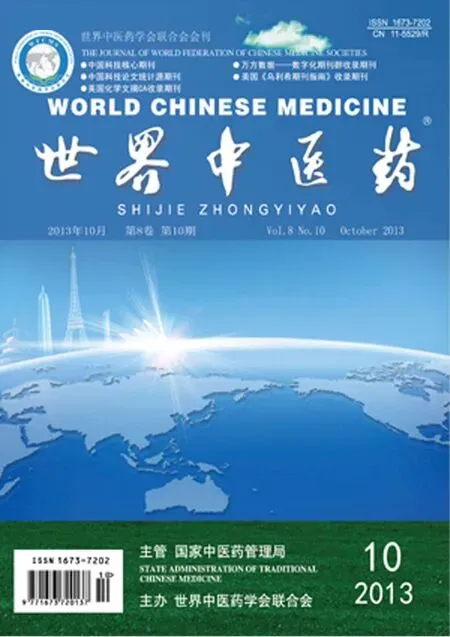馬齒莧多糖對潰瘍性結腸炎相關性結腸癌IL-6/STAT3信號通路的影響
王 倩 范文濤
(陜西中醫(yī)學院,咸陽,712046)
綜 述
馬齒莧多糖對潰瘍性結腸炎相關性結腸癌IL-6/STAT3信號通路的影響
王 倩 范文濤
(陜西中醫(yī)學院,咸陽,712046)
最新研究報道,慢性炎癥是導致腫瘤發(fā)生、發(fā)展的重要因素。結腸、直腸的慢性炎癥導致炎癥局部組織發(fā)生反復的損傷、修復、增生,最終引起癌變。因此,研究如何干預慢性炎癥癌變成為降低結直腸癌的發(fā)生的重要方法。本文探討馬齒莧對腸道炎癥及腫瘤發(fā)生、發(fā)展的影響,及其與IL-6/STAT3通路的關系。為預防炎癥性腸病癌變,提供新的研究思路。
馬齒莧多糖;潰瘍性結腸炎相關性結腸癌;IL-6/STAT3
結直腸慢性炎癥反復損傷、修復、增生,引起基因突變及細胞癌變。因此,炎癥性腸病的早期干預是預防癌變的重要途徑。本文探討馬齒莧對IL-6/STAT3信號通路的影響,為預防炎癥性腸病癌變,降低結直腸癌發(fā)病率,提供新的研究思路。
1 潰瘍性結腸炎相關性結腸癌的發(fā)病機制
潰瘍性結腸炎(uleerativeeolitis,uc)是一種病因復雜的消化道疑難病,在西方國家的發(fā)病率高達234/10萬,在我國也呈逐年上升趨勢。由于結腸炎癥反復發(fā)作,遷延不愈,25月以上病程癌變率高達40%。慢性炎癥的反復損傷、修復、增生、引起基因突變,從而引起細胞癌變,大約有20%的人類癌癥來源于慢性炎癥[1]。據(jù)報道,上海市的結腸癌發(fā)病率、病死率均明顯升高,在眾多惡性腫瘤中其病死率已躍居第2位。因此,對于結腸炎癥的有效治療是阻止結腸炎向結腸癌演變的重要手段[2]。
炎癥因子在潰瘍性結腸炎癌變機制中起著舉足輕重的作用,潰瘍性結腸炎是一種慢性炎癥性病變,癌變模式為炎癥—不典型增生(低度、高度)—癌變。白介素等多種炎癥因子參與潰瘍性結腸炎的癌變過程[3]。臨床研究發(fā)現(xiàn),結腸癌患者的血清和癌組織中IL-6水平均增高,且IL-6的濃度與腫瘤大小、腫瘤轉移、預后和生存率相關[4]。這些結果提示IL-6可能與結腸癌發(fā)病有關。后繼的研究發(fā)現(xiàn),sIL-6R能夠通過調節(jié)結腸腫瘤細胞與血管內皮的粘附促進腫瘤轉移灶形成[5]。在炎性腸病患者中,IL-6信號通路下游關鍵調節(jié)子STAT3持續(xù)活化,而在多種人類腫瘤中也可觀察到STAT3持續(xù)激活,如宮頸鱗狀細胞癌[6]。甚至有學者因STAT3可以誘導培養(yǎng)細胞向癌細胞轉化以及在裸鼠中STAT3促腫瘤形成而將它歸為致癌基因[7]。目前認為,STAT3促腫瘤機制可能是STAT3信號通路上游IL-6信號轉導失調導致p-STAT3增高,進而引起通路下游抗凋亡基因和細胞周期相因子表達失調,最終導致腫瘤的發(fā)生[8]。
2 IL-6/STAT3信號通路在潰瘍性結腸炎相關性結腸癌形成中的作用
IL-6/STAT3信號通路在結腸癌發(fā)病機制中扮演非常重要的角色,有可能成為新的治療靶點[9]。大量臨床和動物實驗證實阻斷IL-6/STAT3通路傳導是治療結腸癌的有效手段,研究發(fā)現(xiàn)阻斷IL-6/STAT3信號通路能夠抑制實驗性黑色素瘤、小鼠前列腺癌以及胃腫瘤的發(fā)生,與其能夠下調下游Bcl-xl分子表達并誘導細胞凋亡有關[9]。這些研究證實,調控IL-6/STAT3通路有潛在的抗腫瘤作用。對炎癥、癌癥中IL -6/STAT3通路的深入研究,為研發(fā)針對此通路的特異性藥物提供了理論基礎[10]。這些新的藥物可以靶向性的針對炎癥瀑布反應中IL-6/STAT3信號通路的效應因子產(chǎn)生作用,進而抑制結腸癌的發(fā)生和發(fā)展。為結腸癌的診療提供新思路,并有可能成為結腸癌治療的有效手段[11]。
3 馬齒莧多糖對IL-6/STAT3信號通路的影響
馬齒莧為馬齒莧科植物馬齒莧(Portulaca oleraceaL.)的干燥地上部分,首載于《神農本草經(jīng)》。性味酸寒,歸肝、大腸經(jīng)。功效主治:清熱解毒,涼血止血,用于熱毒血痢[12]。現(xiàn)代藥理研究發(fā)現(xiàn)馬齒莧包含多糖類、黃酮類、生物堿類等多種化學成分,其中馬齒莧多糖具有抗氧化活性、并能提高小鼠腹腔巨噬細胞的吞噬功能,促進淋巴細胞轉化,調節(jié)機體的免疫功能[13]。能抑制炎癥趨化因子及其受體CINC-1及CXCR2的表達,從而影響中性粒細胞向炎癥區(qū)域的趨化[14]。
多糖是由單糖基通過糖苷鍵連接而成的化合物[15]。越來越多的研究證明,多糖不但能治療使機體的免疫系統(tǒng)受到嚴重損傷的癌癥,還能治療多種免疫缺損疾病,如慢性病毒性肝炎和某些細菌和病毒引起的慢性病,還能治療風濕病之類的疾病,有的多糖還能誘導干擾素的產(chǎn)生[16-17]。總之,多糖具有調節(jié)免疫功能、抗腫瘤、抗病毒病菌、降血糖血脂、抗?jié)儯?8-19]。與其他植物多糖一樣,馬齒莧多糖具有廣泛的藥理作用,主要包括抗腫瘤、抗氧化與調節(jié)免疫功能等作用[20]。
馬齒莧多糖可以明顯促進體外腹腔巨噬細胞的吞噬功能和NO及細胞因子IL-1的產(chǎn)生[21]。巨噬細胞表面存在有多糖受體,馬齒莧多糖可能通過與受體結合激活巨噬細胞,促進巨噬細胞分泌NO和釋放效應因子IL-1,表明馬齒莧多糖可通過活化巨噬細胞,增強機體的免疫反應作用[22]。
4 馬齒莧多糖的抗腫瘤作用
馬齒莧多糖具有明確的抗腫瘤活性,可使小鼠T淋巴細胞數(shù)量增加,體外對肝癌細胞SMMC7721的增殖具有一定的抑制作用,體內可使小鼠S180腹水瘤分裂指數(shù)顯著下降,并能明顯抑制小鼠S180移植性實體瘤生長。可明顯促進淋巴細胞的轉化,增強小鼠腹腔巨噬細胞吞噬能力,可有效的增加荷瘤小鼠脾淋巴細胞的轉化和腹腔巨噬細胞的吞噬能力以及白介素-1(IL-1)和白介素-2(IL-2)的分泌。其作用機制是提高體內細胞免疫功能而發(fā)揮抗腫瘤作用[23]。
因此,采用馬齒莧多糖早期調控IL-6/STAT3信號通路,能有效減少潰瘍性結腸炎癌變,降低結腸癌發(fā)病率,提高患者生存質量,尋找防治結腸癌新的途徑。充分發(fā)揮中醫(yī)藥整體、多途徑、多層次、多靶點的優(yōu)勢,促進中醫(yī)藥現(xiàn)代化的發(fā)展。
[1]Kundu JK,Surh Y J.Inflammation:gearing the journey to cancer[J]. Mutat Res,2008,659(1-2):15-30.
[2]Jones SA,Horiuchi S,Topley N,etal.The soluble interleukin6 receptor:mechanisms of production and implications in disease[J].FASEB J,2007,15(1):43-58.
[3]Sartor R B.Mechanisms of disease:pathogenesis of Crohn’s diseaseand ulcerative colitis[J].Nat Clin Pract Gastroenterol Hepatol,2006,3(7):390-407.
[4]Munkholm P.Review article:the incidence and prevalence of color-ectal cancer in inflammatory bowel disease[J].Aliment PharmacolTher,2006,18(2):1-5.
[5]Seruga B,Zhang H,Bernstein LJ,etal.Cytokinesand their re-lationship to the symptoms and outcome of cancer[J].Nat RevCancer,2008,8(11):887-899.
[6]Galizia G,Orditura M,Romano C,et al.Prognostic significanceof circulating IL-10 and IL-6 serum levels in colon cancer patientsundergoing surgery[J].Clin Immunol,2008,102(2):169-178.
[7]Takahashi H,Inamori M.Life style-related disease and colorec-tal cancer[J].Intern Med,2009,48(3):121.
[8]Ito H,Takazoe M,F(xiàn)ukuda Y,et al.A pilot randomized trial ofa human anti-interleukin-6 receptormonoclonal antibody in ac-tive Crohn’s disease[J].Gastroenterology,2004,126(4):989-996.
[9]劉力,范文濤,張建安,等.馬齒莧膠囊加中藥灌腸治療潰瘍性結腸炎37例[J].陜西中醫(yī),2007,28(10):1323-1325.
[10]劉力,范文濤.馬齒莧在治療糖尿病性腹瀉中的應用[J].現(xiàn)代中醫(yī)藥,2006,26(5):20-22.
[11]劉力,范文濤.馬齒莧膠囊加中藥灌腸治療潰瘍性結腸炎臨床療效分析[J].現(xiàn)代中醫(yī)藥,2007,18(5):31.
[12]劉力,張瑞娜,張建安,等.馬齒莧水煎劑對糖尿病胃輕癱大鼠糖化血紅蛋白與胃動素的影響[J].上海中醫(yī)藥大學學報,2009,23(4):62-65.
[13]劉霞.馬齒莧對腸運動影響試驗研究[J].中國醫(yī)藥導報,2007,4(9):106.
[14]Lassmann S,Schuster I,Walch A,etal.STAT3 mRNA andprotein expression in colorectal cancer:effects on STAT3-induc-ible targets linked to cell survival and proliferation[J].J ClinPathol,2007,60(2):173-179.
[15]Tsareva SA,Moriggl R,Corvinus FM,et al.Signal transduc-er and activator of transcription 3 activation promotes invasivegrowth of colon carcinomas through matrix metalloproteinase in-duction[J].Neoplasia,2007,9(4):279-291.
[16]Corvinus FM,Orth C,Moriggl R,et al.Persistent STAT3 ac-tivation in colon cancer is associated with enhanced cell prolifera-tion and tumor growth[J].Neoplasia,2005,7(6):545-555.
[17]Kusaba T,Nakayama T,Yamazumi K,et al.Expression of p-STAT3 in human colorectal adenocarcinoma and adenoma;cor-relation with clinicopathological factors[J].JClin Pathol,2005,58(8):833-838.
[18]Dymicka-Piekarska V,Matowicka-Karna J,Gryko M,et al.Relationship between soluble P-selectin and inflammatory factors(interleukin-6 and C-reactive protein)in colorectal cancer[J].ThrombRes, 2007,120(4):585-590.
[19]Alonzi T,Newton IP,Bryce P J,et al.Induced somatic inacti-vation of STAT3 inmice triggers the developmentofa fulminantform ofenterocolitis[J].Cytokine,2004,26(2):45-56.
[20]Carey R,Jurickova I,Ballard E,et al.Activation of an IL-6:STAT3-dependent transcriptome in pediatric-onset inflammatorybowel disease[J].Inflamm Bowel Dis,2008,14(4):446-457.
[21]Laurence A,Tato C M,Davidson T S,et al.Interleukin-2 sig-naling via STAT5 constrains T helper17 cellgeneration[J].Im-munity,2007,26(3):371-381.
[22]Harris T J,Grosso JF,Yen H R,et al.Cutting edge:An invivo requirement for STAT3 signaling in TH17 development andTH17-dependent autoimmunity[J].J Immunol,2007,179(7):4313-4317.
[23]Dowdall JF,Winter D C,Andrews E,et al.Soluble interleukin6 receptor(sIL-6R)mediatescolonic tumor cell adherence to thevascularendothelium:a mechanism for metastatic initiation[J].J Surg Res,2002,107(1):1-6.
(2012-12-11收稿)
Effect of Purslane Polysaccharide on Ulcerative Colitis Associated Colorectal Cancer and IL-6/STAT3 Pathway
Wang Qian,F(xiàn)anWentao
(Shanxi University of Chinese Medicine,Xianyang 712046,China)
Latest reports showed that chronic inflammation is an important factor leading to tumors.Chronic inflammation of the colon and rectum would lead to repeated damage,repair and proliferation of the local tissues in inflammation area,and eventually cause cancer.Therefore,finding out how to intervene the chronic inflammation so as to decrease the occurrence of colorectal cancer has become an importantmethod.This article explored the effects of purslane on intestinal inflammation,occurrence and development of tumor,aswell as its relation to IL-6/STAT3 pathway.It provided new research ideas to the prevention of inflammatory bowel diseases.
Purslane polysaccharide;Ulcerative colitis associated colorectal cancer;IL-6/STAT3
10.3969/j.issn.1673-7202.2013.10.044
國家自然科學基金項目(編號:81202847)
王倩(1978—),女,博士,主治醫(yī)師,講師,主要從事消化系統(tǒng)疾病臨床與實驗研究,E-mail:1404113637@qq.com

